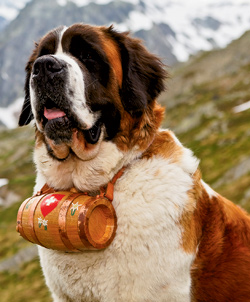Backcountry safety gear has come a long way in the last two decades, never mind since the 1600s. Even so, gear is still no substitute for education, yet it’s always worth looking at how far the sport has come. Here’s a look at some relics that have shaped the last few centuries of backcountry safety.
The Original Search & Rescue: 1600s
Beginning in the mid 1600s, monks living in the Western Alps near St. Bernard’s Pass used the namesake canines with an extraordinary sense of smell for search and rescue. The dogs would find buried travelers on the pass and lie on top of them to provide warmth, while other dogs returned to the nearby monastery for help. This continued for 150 years, saving an estimated 2,000 people. The whiskey barrel around those original St. Bernards’ necks is a myth, though, sparked by a 1820s painting entitled Alpine Mastiffs Reanimating a Distressed Traveller by Edwin Landseer, which showed the dogs equipped with a little pick-me-up. Bottom line: pack your own whiskey barrel. —LH
Avalanche Cord: 1915
In the First World War, Austro-Hungarian Alpine Companies began using avalanche cords while crossing often-dangerous mountain passes. Soldiers would tie the 20-25-meter cords around their waists, and, if an avalanche broke, the light rope unfurled and rose to the surface. The cords were numerically marked every meter, and arrows pointed toward the buried skier. The cords were used regularly until avalanche transceivers rendered them useless in the mid 1900s. —LH
The First Beacon: 1968
Dr. John Lawton, an electrical engineer/pilot working for the Cornell Aeronautical Lab and a volunteer ski patroller at Glenwood Acres Ski Area, N.Y., created the first analog avalanche beacon, formally called Skadi and informally called the Hot Dog. It had a 90-foot range and began retailing in the 1970s at $125. And with a low audio frequency, the Skadi was virtually impervious to outside interference. The Skadi spurred improvements to live-saving technologies that helped drop avalanche recovery times from 120 minutes in 1980s to 35 today. —LH
The First Airbag: 1985
Legend has it that a German hunter caught in an avalanche in the 1970s found that he rose to the snow’s surface thanks to the volume of the game he was shouldering. Peter Aschauer, founder of airbag maker ABS, considered that principle when designing the first avalanche airbag, which utilized compressed air and balloons for the same life-saving effect. His first airbag was patented in 1980 and by 1985 the first fully functioning airbag system was presented at the ISPO exhibition. Thirty years later, the market has literally blown up, with dozens of offerings from brands including ABS, Backcountry Access, Mammut, Black Diamond and WARY. —LH
The First DIN Tech Binding: 1994
While the Dynafit Beast 16 and Marker Kingpin currently boast the only DIN certification among tech bindings, they’re not the first. The Dynafit TLT4 received TÜV certification way back in 1994, though the testing standards to meet DIN ISO 13992—the international certification for AT binding release—have become more rigorous. —TC
The Avalung: 1998
Asphyxiation is the leading cause of avalanche deaths, so in the early 1990s, Tom Crowley, a psychiatry professor at the University of Colorado and backcountry skier, devised the first Avalung-like prototype out of plastic tubing and his wife’s pantyhose. After testing it in the backyard, and then burying his son with the invention—which was designed to bring in oxygen from air-filled snow and disperse carbon dioxide—in a snowpit on Loveland Pass, Crowley knew he was onto something. Then in 1998, Black Diamond introduced the Avalung vest, which first retailed between $200 and $300. In 2001, the lighter, cheaper Avalung II vest debuted before later being incorporated into backpacks. —LH—
From March 7-8, join the editors of Backcountry Magazine at Jackson Hole Mountain Resort for the GORE-TEX Backcountry Basecamp Tour, presented by Voilé, Marmot and AIARE. All weekend, Backcountry Magazine staff will showcase the newest backcountry equipment, AIARE educators will conduct demos and classes, and Jackson Hole Guides will take visitors on complimentary backcountry tours. For more on the event, including the party and raffle to benefit Teton County Search and Rescue, visit backcountrymagazine.com/basecamp.




![Peter Aschauer and his original balloon animal. [Photo] Courtesy ABS](http://backcountrymagazine.com/wp-content/uploads/2015/02/ogabs.jpg)
![The TLT4, circa 1994. [Photo] Courtesy Dynafit](http://backcountrymagazine.com/wp-content/uploads/2015/02/og_tlt.jpg)
![The original, under-snow "breathing" apparatus. [Photo] Courtesy Black Diamond](http://backcountrymagazine.com/wp-content/uploads/2015/02/ogavalung.jpg)








Related posts:
A Teton Bar Crawl: From Jackson’s Mangy Moose to Targhee’s Trap Bar, It’s a Long, Hard Walk
BC Banter: Colorado Mountain College Hosts Climate Change Talk, Avalanche Fatality in Snowbasin bc, …
The Testament, Part One: Turiano produces first half of Jackson Hole Backcountry Skier’s Guide
Backcountry Basecamp Schedule of Events: Crested Butte Mountain Resort